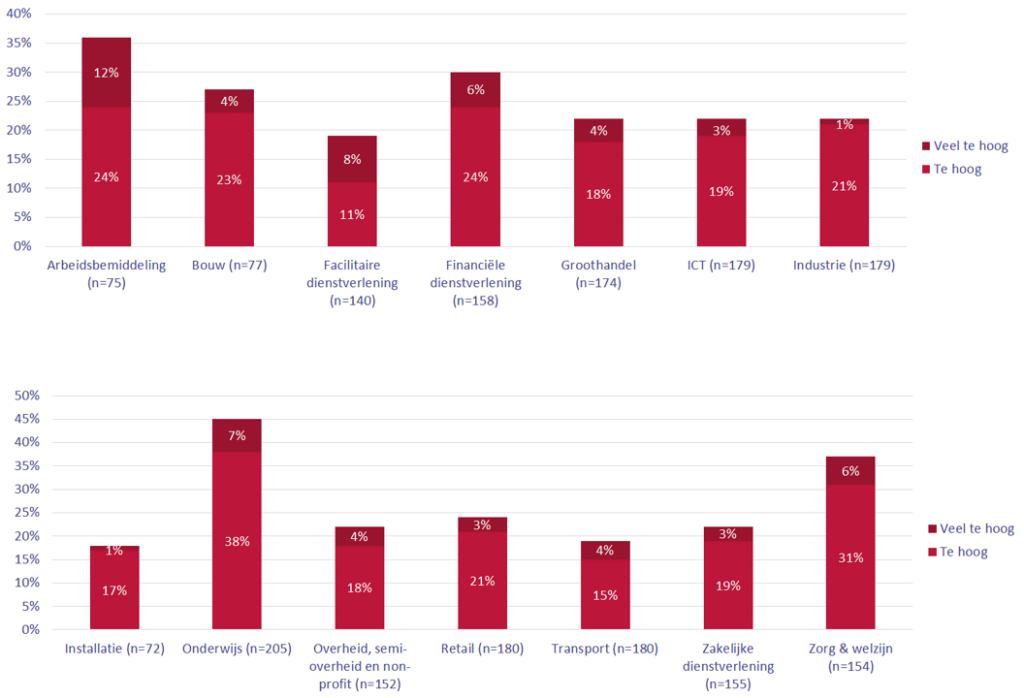Want to learn more about workload? Then read on here!
Workload Monitor
The Role of Character in Workload
Character traits can significantly impact workload and the ability to manage it effectively. Traits such as perfectionism, sensitivity, sub-assertiveness, evidence-driven behaviors, insecurity, and a strong need for appreciation can lead individuals to push beyond their limits or fail to recognize those limits.
Addressing Character Traits in the Workplace
So, what should an organization do about these character traits? Should you avoid hiring individuals with such traits? Fortunately, that’s not necessary. Instead, organizations can help employees manage and balance their character traits to ensure they work for rather than against them.
Here’s how organizations can address and support different character traits:
- Understanding Character Traits: Recognize that traits like perfectionism or a strong need for approval can sometimes lead employees to overextend themselves. It’s important to understand these traits and their potential impact on workload.
- Providing Support: Offer support and guidance to employees with these traits. For instance, someone with high standards might need clear, achievable goals and feedback to avoid setting themselves up for undue stress.
- Addressing Organizational Factors: Certain organizational conditions can exacerbate these traits, leading to an imbalance. For example:
- Lack of Job Security: Employees without permanent contracts may feel the need to prove themselves constantly, leading to excessive stress.
- High Autonomy and Freedom: While autonomy is valuable, it can also tempt employees to overwork themselves if not managed properly.
- Recognition Only for Over-Performance: When appreciation is only given for exceptional performance, employees may feel compelled to continuously overperform, which can be unsustainable.
- Poor Relationship with Supervisors: A strained relationship with a supervisor may lead employees to work harder to prove their worth, increasing their workload unnecessarily.
Strategies for Managers
As a manager, it’s crucial to understand the characteristics and needs of your team members. Here’s how you can support them effectively:
- Know Your Team: Gain a deep understanding of each team member’s character traits and how they might influence their workload and stress levels.
- Use Personality Assessments: Consider using personality tests to gain insights into your team’s characteristics. These tools can offer valuable information and foster more meaningful discussions.
- Address Organizational Factors: Be mindful of how organizational culture and practices might impact employees with certain traits. Work to mitigate factors that may exacerbate their challenges.
- Promote Balanced Work Practices: Encourage balanced work practices and provide support to help employees manage their workload in a healthy way. Recognize and address any risks that could lead to an imbalance.
By understanding and addressing the role of character in workload, organizations can create a supportive environment that helps employees thrive and maintain a healthy balance.
Be Alert to Signals
Before you can apply effective coping strategies, it’s crucial to recognize the signs of an imbalance. Unfortunately, this is where many people falter. Complaints are often not given enough attention, and they may be overlooked as symptoms of something more significant. Managers and colleagues sometimes fail to spot these signs as well.
Recognizing the Signs
Education is the first step toward addressing this issue. As a manager, it’s essential to foster a trusting environment where you truly understand your employees and engage in regular conversations with them. If you notice that someone has been unusually short-tempered or distressed over several days, take the initiative to check in with them. Simply asking how they’re doing can make a significant difference.
Building Trust
The more open you are as a manager, the more likely your employees will be to share their concerns with you. Building a trusting relationship encourages employees to speak up about their challenges, allowing you to provide support before issues escalate.
Want to Learn More?
For additional information on recognizing and addressing stress-related issues, visit Mind’s guide on stress, overstimulation, and burnout.
Rest and Reflection
Rest is crucial for recovery and returning to balance. It also provides valuable time for reflection. During periods of rest, you can take a step back to understand your feelings, thoughts, and the situation that led to imbalance. This self-awareness helps in identifying why you experienced an imbalance and in developing strategies to prevent it in the future.
To facilitate rest and reflection, it’s important to build regular breaks into your routine. Organizations can play a key role in this by emphasizing the importance of taking breaks and managing work hours effectively. If you notice that an employee is consistently working long hours or evenings, initiate a conversation about their workload and rest.
Actively check in with colleagues to ensure they have sufficient time for rest and reflection. Support them in creating a more balanced and regular work routine. Encouraging this approach not only helps prevent burnout but also promotes overall well-being and productivity.
Ignorance Among Young People
Young people are often more prone to burnout, and several factors contribute to this:
- Phase of Many Firsts: Young adults are navigating a phase filled with many new experiences, both professionally and personally. This can lead to heightened stress as they adapt to multiple changes and challenges.
- Limited Work Experience: With less experience, young employees may struggle to gauge their own limits and effectively manage their workload. They might not yet have developed the skills to balance demands with their capacity.
- Difficulty in Matching Workload to Capacity: Young individuals often lack the self-awareness and experience needed to align their workload with their personal limits. This can result in them taking on more than they can handle.
Supporting Young Employees
Organizations can play a crucial role in supporting young employees:
- Regular Check-Ins: Frequently assess their workload and ensure it aligns with their capacity. Offer support and make adjustments as needed.
- Encourage Reflection: Provide opportunities for young employees to reflect on their experiences and workload. This can help them understand their limits and develop better coping strategies.
- Mentorship and Guidance: Offer mentoring and guidance to help young employees build resilience and work-life balance.
By actively supporting young employees and addressing these challenges, organizations can help prevent burnout and foster a healthier, more productive work environment.
Work Smarter, Not Harder
Working harder isn’t always the best solution. In fact, it can sometimes be counterproductive. Instead, focus on working smarter. Here’s how:
Set Priorities
Begin each day by identifying and prioritizing the most important tasks. Create a to-do list and rank tasks in order of importance. This keeps you focused and ensures that critical tasks are completed first.
Avoid Distractions
Minimize distractions in your work environment. Maintain a tidy workspace, turn off unnecessary notifications, and schedule specific times to check emails. This helps maintain concentration and productivity.
Work in Blocks
Use time blocks for focused work, followed by regular breaks. The Pomodoro Technique (25 minutes of work followed by a 5-minute break) is effective for boosting productivity and maintaining focus.
Delegate Tasks
Delegate tasks to others and trust your team to handle them. This not only balances the workload but also supports the development of your colleagues.
Automate Repetitive Tasks
Implement automation for routine tasks. Use automated email responses, templates for common documents, and automated reporting to save time and reduce errors.
Learn to Say ‘No’
Recognize that not every task or project needs immediate attention. Politely decline additional projects or meetings that do not align with your key objectives. This helps conserve your time and energy.
Hold Short Meetings
Meetings can often be time-consuming. Keep them brief and focused by setting a clear agenda and adhering to it. Consider standing meetings to keep everyone engaged and shorten the duration.
By applying these strategies, you can work more efficiently and effectively, ultimately enhancing both productivity and job satisfaction.
Also read these articles
Why it’s important to take breaks and stimulate: https://openup.nl/blog/pauze-nemen/
The mental health taboo in the workplace: https://www.trendsinhr.nl/het-mental-health-taboe-op-de-werkvloer/
Practical tips to relieve stress: https://openup.nl/blog/stressverlichting-onderweg/
Decision fatigue: https://chro.nl/artikel/beslis-moeheid-leidt-in-de-loop-van-de-dag-tot-slechtere-besluiten-pauzeren-is-essentieel/
Work-life balance trends: https://openup.nl/blog/de-werk-privebalans-verandert-trends-en-risicos-waar-je-op-wil-letten/
Tips for better concentration: https://psycholoog.nl/blog/10-tips-om-je-beter-te-concentreren/
Exercise and work stress: https://boommanagement.nl/artikel/werkgever-moet-bewegen-faciliteren-om-werkstress-te-verminderen/
This is forgotten in dealing with stress: https://chro.nl/artikel/hoe-verbetert-u-het-welzijn-van-uw-werknemers/
Or read these books
The Ladder – Ben Tiggelaar
Changing behavior using a very simple model.
Socrates on Sneakers -Elke Wiss
The art of asking good questions.
Tiny Habits – BJ Fogg
Easy way to create new habits.
Focus on/off – Mark Tighelaar
Close the 4 concentration gaps and get more done in a world full of distractions.
GRIP – Rick Pastoor
The secret of smart working
Never too busy again – Tony Crabbe
A tidy head in a crowded world
Saving time-Every day at 3 p.m. – Bjorn Deusings
From busy to productive and more restful
Or listen to these podcasts
Manage your energy – Ben Tiggelaar Podcast
https://www.bnr.nl/podcast/ben-tiggelaar-podcast/10492853/werktip-ben-tiggelaar-manage-je-energie
Why you need to work on your energy before it’s too late – Ben Tiggelaar Podcast
https://www.bnr.nl/podcast/ben-tiggelaar-podcast/10491645/waarom-je-aan-je-energie-moet-werken-voor-het-te-laat-is
Mark Tigchelaar on Focus – DRIVE Podcast
https://marktuitert.nl/podcast/drive-18-mark-tigchelaar-focus-aan-uit/ Elke Wiss on Asking Good Questions – DRIVE Podcast
https://marktuitert.nl/podcast/drive-31-elke-wiss-goede-vragen-stellen/
What energy type are you?
Manage your energy – Vitality podcast
https://thebodypractice.nl/podcast/38-welk-energietype-ben-jij-zo-manage-je-jouw-energie/
Less workload?
Then stop here – Vitality Podcast https://thebodypractice.nl/podcast/32-miniserie-1-5-minder-werkdruk-stop-dan-hiermee/



